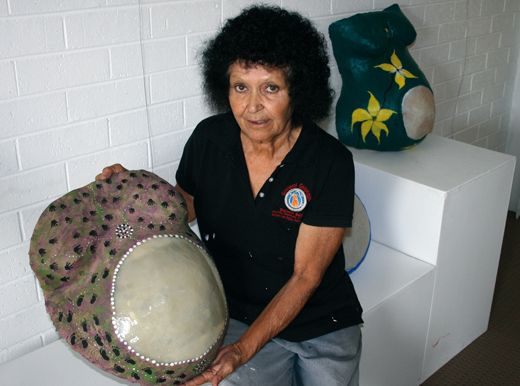
The beautiful paintings and sculptures adoring the walls of the ‘Gomeroi gaaynggal’ art gallery in Tamworth have significance well beyond the aesthetic.
The beautiful paintings and sculptures adoring the walls of the ‘Gomeroi gaaynggal’ art gallery in Tamworth have significance well beyond the aesthetic.
All have been created by indigenous women who belong to the ‘Gomeroi gaaynggal’ mothers’ art and health program.
The leader of HMRI’s Pregnancy and Reproduction Program, Professor Roger Smith from the Universityof Newcastle, and local community Program co-ordinator Dr Kym Rae are investigating ways to achieve healthier pregnancies for indigenous women, because the statistics are worrying.
An indigenous baby born today is 40 times more likely to suffer severe kidney problems than a non indigenous child. And their mothers are twice as likely to give birth prematurely.
“Health starts inside the uterus, the research data strongly suggests that if a mother has diabetes when pregnant that it can damage the pancreas of the developing baby. This predisposes the baby to developing diabetes once born,” Professor Smith said.
“Equally if the mother has kidney damage during pregnancy, the baby’s kidneys try to over compensate which also results in damaging the baby’s kidneys”.
“The project seeks to engage Aboriginal women early in their pregnancy through the medium of art and to help ensure that kidney disease and diabetes is being well treated” Professor Smith said.
Creating culturally inclusive, community-based arts and health program was the solution.
“Before the program began the only ante-natal services that were available were those offered at the private hospital. It became obvious that this type of care did not effectively translate to young Indigenous mothers,” Dr Rae said.
“The arts program provides an informal environment where mothers and their children and families can participate in a number of artistic, educational and community based activities.”
“The centre provides mothers with a creative space where they can engage with each other while also receiving important health education in a very relaxed way.”
Health professionals paint with the women while chatting to them about their babies wellbeing.
“The dietitian who visits the program has been working on an artwork got over a year now,” Dr Rae said. “The mothers have become very involved in helping her tell story through her painting and, in turn, they have also been confident to engage with the health information she has provided them with.”

Symbolising the success of the program are painted plaster casts of pregnant bellies, which have a translucent panel displaying ultrasound images. One intricately painted cast even displays ultrasound footage on the glowing panel while the beat of the unborn child’s heart plays throughout the gallery.
The ultrasounds, in turn, allow medical staff to gauge foetal growth, while the study also monitors renal function and nutrition levels.
“Not only is there a better health awareness but generations of indigenous women are able to reconnect with each other in a new way. The women are forming strong relationships with their culture and are more confident,” Dr Rae said.
With the program representing the first Indigenous cohort of pregnant women in the world Professor Smith is confident that the positive impacts will continue both locally and internationally.
“I think this is an exciting interaction between art and science that could have an enormous impact on future generations on Aboriginal people,” Professor Smith said.
“We hope that the lessons learnt in through this program might be applicable to indigenous people in other parts of the world like New Zealand, Canada and America.”
Her Excellency Professor Marie Bashir, Governor of NSW, was recently appointed as Patron.
The Thyne Reid Foundation assisted with the initial project grant in 2008 through HMRI. It has since attracted Federal Government (NHMRC) funding.
* Article by Ellie McNamara, HMRI Communications Assistant
HMRI is a partnership between the University of Newcastle, Hunter New England Health and the community.
HMRI would like to acknowledge the Traditional Custodians of the land on which we work and live, the Awabakal and Worimi peoples, and pay our respects to Elders past and present. We recognise and respect their cultural heritage and beliefs and their continued connection to their land.

Hunter Medical Research Institute
We’re taking healthy further.
Locked Bag 1000
New Lambton
NSW, Australia, 2305



This site is protected by reCAPTCHA and the Google Privacy Policy and Terms of Service apply.
Copyright © 2024 Hunter Medical Research Institute | ABN: 27 081 436 919
Site by Marlin Communications
